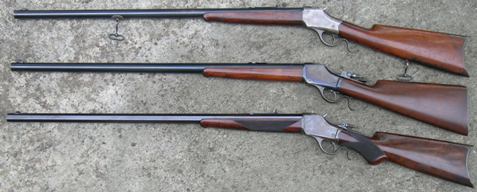I have a Winchester 1873 3rd variation 32-20, date of manufacture 1903. I have completely disassembled the rifle and wanted to see if I could get a few tips for cleaning. I don’t want to actually perform a restoration but want to just clean the wood and metal and keep the actual character of the firearm.
As for the wood I have read to remove all metal parts and use dishwashing soap and water, lightly scrubbing making sure not to get water in the unfinished areas of the stock and forearm. Then some say use linseed oil as the next step then followed by a wax coat for long term protection. I sent an email to Birchwood Casey about their wood finishing products Stock Sheen & Conditioner and Gun Stock Wax however I never heard any feedback back.
The metal parts are mostly covered in patina, very light or no bluing left with light surface rust in a few areas, again very light. Some very light freckling and pitting, not excessive. I have read some use an old copper penny or brass wool with gun oil. However I don’t want to strip it down to the bare metal/scratched look as I have seen some do.
By the way do not pay attention to the rear site as you have already kindly helped me find the correct period specific Semi buckhorn sight.
Attached are some pictures to better asses the condition.
Thanks,
Phil
i’m sure some of the other guys will have a better way to do this, but this is what i do for light cleaning of surface rust or grime build up.
I take an old casing (i have a 30-30 and a .243 case) and crimp the open end flat. Then i put Hoppes on the barrel/parts and gently scrape old gunk or small rust spots. Since the brass is softer then the frame it shouldn’t leave any marks or take off the finish. I have had success doing it this way. Again, i stress the word gently…….
Bert H. said
A can of Kroil, and several fine mesh copper wool pads is all you need to clean all of the steel surfaces. 100% pure acetone can be used to remove old oil, grease, and gun powder residue.
Bert
Phil :
Bert is right on with the Kroil and copper pads. I had an 1890 barrel that was covered with rust – some surface and pitted. I bought some copper wool ( not copper covered steel.) at the local Ace hardware store. With Kroil and the wool the rust was removed and no damage to the blue. Win 61
November 7, 2015
 Offline
OfflineI use Birchwood Casey’s stock sheen and conditioner to clean grime off old wood.
– For metal parts I agree with Bert’s method. Kroil is a great product. Great pre-soak for those difficult old screws as well. I also used Kroil on a couple of bores that were in bad condition. Removed a lot of rust and other gunk that solvent failed to remove.
– For the wood, I have used a soft brush with mineral spirits to remove oil and grime. Does pretty well without getting too aggressive on the existing finish. Be aware this will probably dry out the surface of the wood so some follow-up treatment may be required.
Patience is the key…
Ok I think I have the metal parts nailed down now, thank you.
1st) Apply Kano Kroil Penetrating Oil with fine mesh copper wool pads to remove rust and metal aging from exposure.
2nd) Apply 100% pure acetone to remove oil, grease, and gun powder residue.
3rd) Lastly, gun oil to protect.
As for the wood has anyone had experience with using dishwashing soap and water? Then use linseed oil as the next step then followed by a wax coat for long term protection.
So far I have a couple of suggestions. 1) Birchwood Casey’s stock sheen and conditioner 2) Soft brush with mineral spirits to remove oil and grime.
Thanks,
Phil
Phil,
To me, the wood looks pretty good as is, so stay conservative. Me–I have had good success using lemon oil and a soft cotton rag to clean and somewhat nourish the finish that is already there. White cotton (old tee shirt, say) will show the degree of dirt/grime lifted and floated away with the lemon oil. If that is insufficient for you, then you could try other methods that get more aggressive.
Tim
The receiver end of the stock looks like it has years of oil soaked into it, though the integrity of the wood seems to be intact. Once you’ve cleaned the surface, if that dark spot remains, I’m afraid that the only way to remove it (or lessen it) will be to remove the finish and soak the stock to extract the oil. If what I suspect is right, the front end of the stock will never match the rest of the wood but it should improve considerably.
![]()
"This is the West, sir. When the legend becomes fact, print the legend."
Thanks guys for the advice.
Other than wiping off the grime I will leave cartridge carrier alone.
Also on an 1873 32-20 caliber variation 3, manufacture date 1903 is the carrier supposed to be made of brass or bronze material?
Looking at my 1873 parts schematic it does not indicate the carrier block material for a 32-20 caliber. It does have a 44-40 caliber listed as Brass. Was there carrier blocks made with different materials to support different calibers ranges?
Thanks,
Phil
1 Guest(s)


 Log In
Log In Members
Members Home
Home

 Add Reply
Add Reply Add Topic
Add Topic

















